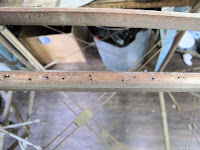I've decided as I remove things I should repair or make new parts as I go. This is the time when I have the most information about how the parts were installed, etc. I think it's easier to get things right now then it will be a year or 2 from now.
Fortunately the first thing I've taken off doesn't need repair because it's not going back on the plane.
This picture was taken when the plane was about 1 year old and like all NINEs it does not have a headrest. Remember they were trying to build the Model T of the air, cheap transportation.In 1929 when Spangler and Fink owned the plane it still did not have a headrest.
Spangler sold his share to Betz and I have some pictures from 1931 while he and Fink owned it. One picture shows no headrest. In this picture however, the plane has new fabric and the headrest has been added. In this and another picture it looks like all the metal has been painted black, as it is still today.
Spangler sold his share to Betz and I have some pictures from 1931 while he and Fink owned it. One picture shows no headrest. In this picture however, the plane has new fabric and the headrest has been added. In this and another picture it looks like all the metal has been painted black, as it is still today.
The fuselage fabric eventually got painted black also.
Pretty simple headrest, a rolled piece of aluminum, a block of wood, some padding, tacks and leatherette covering.
There's some old fabric covering and original Dutch Blue paint on the sheet metal. I wonder if I could fix up this cowl piece and keep that little bit of original blue paint showing. That would be fun.
There's some old fabric covering and original Dutch Blue paint on the sheet metal. I wonder if I could fix up this cowl piece and keep that little bit of original blue paint showing. That would be fun.
They clearly removed some of the padding material under the leatherette in order to get the headrest to set down tightly to the cowling. The old pictures show it nice and round in this area as well as the rest. We'll get to all that cockpit coming material once the cowling is removed. The bulge along the edge is due to the rolled edge they put on the cockpit opening for stiffening, more fun for later.
This blue paint made me wonder about the Travel Air radiator I had. It looks to me like Travel Air also painted their planes with Valspar Dutch Blue, nice color, commercially available.
The fabric on the fuselage was painted black but not under the headrest. Someone recovering the plane and painting the fabric black would probably have painted the fabric before reinstalling the sheet metal. This piece of fabric is probably from the 1931 recovering. The plane only flew 7 more years. If it was hangared there would not be a need to recover the fuselage that soon.
This blue paint made me wonder about the Travel Air radiator I had. It looks to me like Travel Air also painted their planes with Valspar Dutch Blue, nice color, commercially available.
The center stringer on the turtle deck is double width to allow the 2 side pieces of fabric to be nailed to it during covering. The nail hole spacing looks like only the factory nailed the fabric to this stringer.
When you roll back the remaining piece of fabric you can see that the last time the fuselage was covered they used a sewn envelope instead of the blanket method. Therefore they didn't need to nail the fabric to the stringer. The seam is a single row of stitching and the excess fabric is very neatly trimmed to 1/4" from the stitching.
This simple little headrest has been a lot of fun and very informative. On to the next piece.
This simple little headrest has been a lot of fun and very informative. On to the next piece.













No comments:
Post a Comment